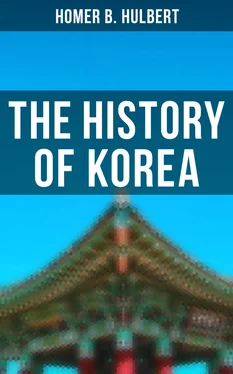Before passing to the account of the founding of the three great kingdoms of Sil-la, Păk-je and Ko-gu-ryŭ, we must give a passing glance at one or two of the great border tribes of the north-west. They were not Koreans but exercised such influence upon the life of Korea that they deserve passing notice.
In that vast tract of territory now known as Manchuria there existed, at the time of Christ, a group of wild tribes known under the common name Mal-gal. The group was composed of seven separate tribes, named respectively—Songmal, Păk-tol, An-gŭ-gol, Pul-lal, Ho-sil, Heuk-su (known also as the Mul-gil)and the Păk-san. Between these tribes there was probably some strong affinity, although this is argued only from the generic name Mal-gal which was usually appended to their separate names, and the fact that Mal-gal is commonly spoken of as one. The location of this group of tribes is determined by the statement (1) that it was north of Ko-gu-ryŭ and (2) that to the east of it was a tribe anciently called the Suk-sin (the same as the Eum-nu,) and (3) that it was five thousand li from Nak-yang the capital of China. We are also told that in it was the great river Sog-mal which was three li wide referring it would seem to the Amur River. These tribes, though members of one family, were constantly fighting each other and their neighbors and the ancient records say that of all the wild tribes of the east the Mal-gal were the most feared by their neighbors. But of all the Mal-gal tribes the Heuk-su were the fiercest and most warlike. They lived by hunting and fishing. The title of their chiefs was Tă-mak-pul-man-lol-guk. The people honored their chiefs and stood in great fear of them. It is said that they would not attend to the duties of nature on a mountain, considering, it would seem, that there is something sacred about a mountain. They lived in excavations in the sides of earth banks, covering them with a rough thatch. The entrance was from above. Horses were used but there were no other domestic animals except pigs. Their rude carts were pushed by men and their plows were dragged by the same. They raised a little millet and barley, and cultivated nine kinds of vegetables. The water there, was brackish owing to the presence of a certain kind of tree the bark of whose roots tinged the water like an infusion. They made wine by chewing grain and then allowing it to ferment. This was very intoxicating. For the marriage ceremony the bride wore a hempen skirt and the groom a pig skin with a tiger skin over his head. Both bride and groom washed the face and hands in urine. They were the filthiest of all the wild tribes. They were expert archers, their bows being made of horn, and the arrows were twenty-three inches long. In summer a poison was prepared in which the arrow heads were dipped. A wound from one of these was almost instantly fatal. The almost incredible statement is made in the native accounts that the dead bodies of this people were not interred but were used in baiting traps for wild animals.
Besides the Mal-gal tribes there were two others of considerable note, namely the Pal-hă and the Kŭ-ran of which special mention is not here necessary, though their names will appear occasionally in the following pages. They lived somewhere along the northern borders of Korea, within striking distance. The last border tribe that we shall mention is the Yŭ-jin whose history is closely interwoven with that of Ko-gu-ryŭ. They were the direct descendants, or at least close relatives, of the Eum-nu people. They were said to have been the very lowest and weakest of all the wild tribes, in fact a mongrel tribe, made up of the offscourings of all the others. They are briefly described by the statement that if they took up a handful of water it instantly turned black. They were good archers and were skilful at mimicing the deer for the purpose of decoying it. They ate deer flesh raw. A favorite form of amusement was to make tame deer intoxicated with wine and watch their antics. Pigs, cattle and donkeys abounded. They used cattle for burden and the hides served for covering. The houses were roofed with bark. Fine horses were raised by them. It was in this tribe that the great conquerer of China, A-gol-t’a, arose, who paved the way for the founding of the great Kin dynasty a thousand years or more after the beginning of our era.
Southern Korean. … Ki-jun’s arrival … differences which he found … three groups. … Ma-han … position … peculiarities … characteristics … worship … tatooing … numbers. … Chin-han. … Chinese immigration … customs. … Pyön-han … position … habits … the philological argument … southern origin. … Ki-jun and his descendants.
We must now ask the reader to go with us to the southern portion of the peninsula where we shall find a people differing in many essential respects from the people of the north, and evincing not merely such different but such opposite characteristics from the people of the north that it is difficult to believe that they are of the same origin.
When King Ki-jun, the last of the Ki-ja dynasty proper was driven from P’yŭng-yang by the unscrupulous Wi-man, he embarked, as we have already seen, upon the Ta-dong River accompanied by a small retinue of officials and servants. Faring southward along the coast, always within sight of land and generally between the islands and mainland, he deemed it safe at last to effect a landing. This he did at a place anciently known as Keum-ma-gol or “Place of the Golden Horse,” now Ik-san. It should be noticed that this rendering is simply that of the Chinese characters that were used to represent the word Keum-ma-gol. In all probability it was a mere transliteration of the native name of the place by the use of the Chinese, and the rendering here given was originally unthought of.
They found the land inhabited, but by a people strange in almost every particular. The explicitness with which all native accounts describe the people whom Ki-jun found in the south is in itself a striking argument in favor of the theory that a different race of people was there encountered. The southern part of the peninsula was divided between three groups of peoples called respectively Ma-han, Chin-han and Pyön-han. How these names originated can hardly be learned at this date, but it would seem that they were native words; for the last of the three, Pyön-han, was also called Pyön-jin, a word entering into the composition of many of the names of the towns peopled by the Pyön-han tribes. It is necessary for us now to take a brief glance at each of these three groups, for in them we shall find the solution of the most interesting and important problem that Korea has to offer either to the historian or ethnologist.
The Ma-han people occupied the south-western part of the peninsula, comprising the whole of the present province of Ch’ung-ch’ŭng and the northern part of Chŭl-la. It may have extended northward nearly to the Han river but of this we cannot be sure. On its north was the tribe of Nang-nang, on the south was probably a part of Pyön-han but one authority says that to the south of Ma-han were the Japanese or Wă-in. These Japanese are carefully described and much color is given to this statement by certain coincidences which will be brought out later. No Korean work mentions these Japanese and it may be that the Japanese referred to were those living on the islands between Korea and Japan. But we can easilyimagine the thrifty islanders making settlements of the southern coast of Korea.
The first striking peculiarity of the Ma-han people, and one that differentiates them from the northern neighbors, was the fact that they were not one tribe but a congeries of small settlements each entirely independent of the others, each having its own chief, its own army, its own laws. It is said that they lived either among the mountains or along the coast, which would point to the existence of two races, the one inland, indigenous, and the other, colonists from some other country. The Ma-han people were acquainted with agriculture, sericulture and the use of flax and hemp. Their fowls had tails ninety-five inches long. Here is one of the interesting coincidences that uphold the contention that the Japanese were in the peninsula at that time. These peculiar fowls are now extinct, but, within the memory of people now living, such fowls were quite common in Japan and preserved specimens in the museum at Tokyo show that the above measurements are by no means unusual in that breed of fowl. It would seem then that Japan procured them from Korea, or else the Japanese colonists introduced them into Korea.
Читать дальше









